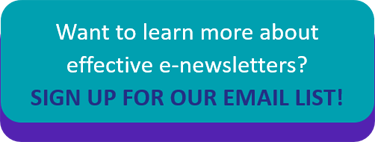Think about an average day in the life of your email inbox. Amidst all of the spam, advertisements for new products and services offered by businesses you’ve worked with in the past, invitations to workshops and conferences, as well as personal messages, how many of those emails do you open? What does it take to capture your attention, keep you engaged and entice you to click through when you open a message?
These are the factors you need to consider when creating a B2B email newsletter. A 2016 report from the Content Marketing Institute found that 81 percent of B2B companies use email newsletters as a content marketing strategy. Your email will compete for time and attention amongst all of the other pieces of mail in your clients’ inboxes. It’s imperative that your organization’s content stand out – not just with a catchy subject, but with interesting and useful content once the recipient takes the time to open it.
Here are some tips for creating powerful B2B email newsletters that will help increase your engagement with the buyers and prospective buyers on your contact list.
Choose an Attention-catching Subject Line for Your B2B Email Newsletter
A great subject line can make the difference between your B2B email newsletter getting opened and read versus moved to the trash bin. Businesses are interested in information that will help them grow, expand their profitability, and optimize their operations. Talking about the latest trends and how to achieve measurable benefits is a sure-fire way to create an eye-opening newsletter subject line.
Don’t Inundate Your Contacts with Messages
Given the overwhelming amount of email most of us receive, it’s no wonder smart businesses allow their contacts to fill out forms to specify the email frequency and types of emails they would prefer.
If a contact has indicated they would like to receive your newsletters, how often should you send them out? Is it best to send short updates every few days or a longer newsletter once a month? Entrepreneur suggests every 14 days as a potential sweet spot to stay at the forefront of your contacts’ minds without annoying and driving them to hit the “Unsubscribe” button. It also suggests using testing to determine which frequency rates work best. No matter how engaging your B2B email newsletters are, it won’t matter if you’re sending them so often that your subscription numbers begin to drop.
Segment Your Audience
Each of your clients has a goal or an interest that drives their business. For some, it may be cutting-edge technology. For others, it could be cybersecurity. One of the keys to creating an engaging B2B email newsletter is this: create a few different B2B email newsletters. Tailor each one to a specific interest and audience. Then segment your contact list with user data you’ve collected in order to ensure that each contact is receiving the newsletter that targets their specific interest area. This will improve your open rate but, more importantly, it’ll improve your click-through rate because your newsletters will reach an audience that wants to learn more.
Ratchet Back the Salesy Language
While it’s important to feature calls-to-action in your B2B email newsletter, if a recipient opens it up and is immediately slammed with “Act Now” “Call Now” “Don’t Miss Out” language, they’re going to unsubscribe. While the purpose of your business’s email newsletter is to add to your client base and increase sales, you’ve got to be careful in the way you develop your emails. Your audience wants to feel as though the newsletter was custom-created for them, so be sure to educate more than you advertise. Give interesting information that is useful for their specific industry, and present your product or service as a potential solution to problems they may be facing.
The key to an effective email newsletter is threefold: catch your audiences’ attention, keep them interested, and engage them enough to motivate them to click through to your site or landing pages to learn more. By keeping these tips in mind, your B2B email newsletters will soon be at the top of your contacts’ must-read list.


.png)